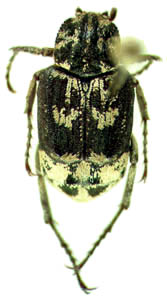| |
|
| Classification |
........Valgus
hemipterus
Linnaeus, 1758
........Valgus hemipterus Linnaeus, 1758:351 (valid name)
........Valgus hemipterus rufosquamatus Dalla Torre, 1879:115 (junior synonym)
........Valgus hemipterus rubi Baguena, 1955:293 (junior synonym) |
| 
|
|
| male |
female |
Valgus
hemipterus . Images by K. A. Swoboda |
| |
Map
showing the distribution of Valgus hemipterus. |
|
| |
| Cetoniinae Tribes
|
| |
| |
| Cetoniinae
Taxa Map |
| Key
to species of Valgini
|
| |
| |
| |
| |
| |
| |
| |
| |
| |
| |
| |
| |
| |
| |
| |
| |
| |
| |
| |
| |
Description:
Pronotal disc serrate along lateral edges, transverse medial ridges
not well developed, basal margin rounded; female with acuminate pygidial
spine with central groove near apex, groove with irregular lateral serrations;
in both sexes, first segment of posterior tarsus as long as segments
two, three and four combined; both sexes black with dark setae, patches
of light-colored setae on pronotum and elytra, males with abundant light-colored
setae on propygidium and pygidium, females with less light-colored setae
on propygidium and pygidium; length 8.0-9.0mm.
|
| |
| |
| |
| |
| |
| |
| |
| |
| |
Distribution: Palaearctic
(Algeria, Europe, Iran, Morocco, southern Sibera and Tunisia) and Nearctic:CANADA: Ontario. USA: Michigan, Ohio.
|
| |
| |
| |
Biological
Data: Larvae have been collected in summer, and pupae and teneral
adults in the early fall, suggesting a univoltine life cycle with adults
and pupae overwintering. Adult females are attracted to moist, rotting
wood to oviposit, although oviposition has been observed in fairly dry
wood and in living trees. Females leave colonized wood to seek out new
oviposition sites in early summer and use their pygidial spines to create
such sites. The entire life cycle of Valgus hemipterus can
be completed within a log, and Nearctic specimens have been taken from
rotting wood of the American elm (Ulmus americana L.). Oak,
birch, elm, and chestnut are common host trees in Europe.
|
| |
| |
| |
| |
| |
| |
| |
| |
| |
| |
| |
Temporal
Distribution: Nearctic: May-June. Palearctic: April- June and October-November.
|
| |
| |
Larvae:
Larvae are not associated with termites, although comparisons have been
made between larval galleries tunnelled by Valgus hemipterus
and those formed by termites. Medvedev (1969) described the third-stage
larvae.
|
| |
| |
| |
| |
References:
FALLOU, J. 1889. Sur les ravages causes par deux coleopteres
nuisibles des environs de Paris. Rev. Sci. Nat. app. 36:58-64.
JAMESON, M.L. and K.A. SWOBODA. 2005. Synopsis of scarab beetle tribe Valgini (Coleoptera: Scarabaeidae: Cetoniinae) in the New World. Ann. Entomol. Soc. Am. 98(5): 658-672.
KRIKKEN, J. 1986. Provisional checklist of the Valginae
(Coleoptera: Cetoniinae). Haroldius 1:1-17.
MAHAR, J. 1989. A new location for Valgus hemipterus
(Coleoptera: Scarabaeidae). Great Lakes Entomologist 22(1):55.
MAHAR, J. and M.P. OEMKE. 1981. A North American record
for Valgus hemipterus (Coleoptera: Scarabaeidae) and information
on its life cycle. Great Lakes Entomologist 14(2):77-79.
MEDVEDEV, S.I. 1969. On the larvae of Valgus hemipterus
L. (Coleoptera: Scarabaeidae). Entomol. Rev. 48:100-101.
SCHENKLING, S. 1922. Coleopterorum Catalogus, pars.
75. Scarabaeidae: Trichiinae, Valginae. West Junk, Berlin. 58 pp.
|
| |
| |
| |
| |
| |
| |
| |
| |
| |
| |
| |
| |
| |
| |
| |
| |
| |
| |
| |
| |
| |
| |
| |
| |
|
| |

